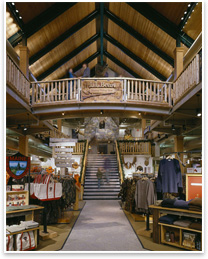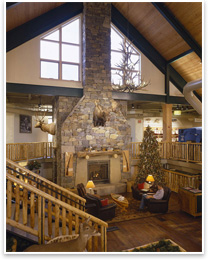
 From Demise, New Life for L.L. Bean From Demise, New Life for L.L. BeanWood and steel from demolished building provide structure for new store How do you . . . design a new retail store with materials from an old store? Summary: As the mythical phoenix rises from its ashes, so too L.L. Bean’s new Hunting and Fishing store was birthed largely from the remains of its aged predecessor.
Find out what’s happening with the Committee on the Environment (COTE). Learn more about L.L. Bean’s commitment to the environment and supporting sustainable buildings. “Off Grid: Ideas for Building a Carbon-Neutral Future” The AIA’s resource knowledge base can provide you with information on green building practices, including a report on challenges and opportunities of designing for climate change. Outdoor retailer L.L. Bean is based in Freeport, Maine, an unassuming town of about 2,000 that annually hosts 3 million visitors to the L.L. Bean flagship campus, open 24 hours a day and 365 days a year. The newest building on the 200,000-square-foot campus is the Hunting and Fishing store, designed by Sean Selby, AIA, an associate with Arrowstreet in Somerville, Mass. Recently LEED® Silver certified, the store is the first LEED certified retail project in the state and one of nine LEED registered projects for the company. Selby notes that L.L. Bean’s directive to erect a LEED-certified store was decided early in the project. “L.L.Bean has a strong commitment to protecting and preserving outdoor spaces,” says Senior Vice President and General Manager of Retail Ken Kacere. “Because of this commitment, it is important for the company to create a sustainable retail environment for our customers.” New out of old
Local products, local care
The way they do things |
||
Copyright 2008 The American Institute of Architects. All rights reserved. Home Page |
||
news headlines
practice
business
design
recent related
› “Greenstep” Video #9 Highlights Daylighting
› Going Green on a Budget
› Outdoor Retailer Sees Green Inside and Out
Photos
Photos © Brian Vanden Brink.
1. The L.L. Bean Hunting and Fishing Store’s large porch is made from reclaimed wood, and its large, operable windows automatically vent when CO2 levels peak.
2. The interior of the L.L. Bean Hunting and Fishing store features recycled rubber flooring and carpets, along with salvaged timber and steel.
3. It doesn’t get more local than this: the stone for the hearth was crafted two miles away.

 Big & Green: Toward Sustainable Architecture in the 21st Century,
Big & Green: Toward Sustainable Architecture in the 21st Century, “If you look up in the store, you see a lot of wood on the ceiling. If you walk into the front door, you walk along the porch. All of that wood is from the old outlet store. We were able to reuse wood and claim it for LEED points, which is always a good thing,” explains Selby. In addition to repurposing structural timbers, bead board, and floor board, the company also recycled materials from the outlet store for product fixtures. “If you look around in the hunting and fishing store, all of the store fixtures are pieces of wood and chunks of steel from other stores and they recycled or remilled and turned them into something new. They’re starting to do that more and more.”
“If you look up in the store, you see a lot of wood on the ceiling. If you walk into the front door, you walk along the porch. All of that wood is from the old outlet store. We were able to reuse wood and claim it for LEED points, which is always a good thing,” explains Selby. In addition to repurposing structural timbers, bead board, and floor board, the company also recycled materials from the outlet store for product fixtures. “If you look around in the hunting and fishing store, all of the store fixtures are pieces of wood and chunks of steel from other stores and they recycled or remilled and turned them into something new. They’re starting to do that more and more.” Some of the other sustainable strategies included using structural steel fabricated from recycled material, interior walkways finished with recycled rubber or carpet, 100 percent stormwater management, low-flow sinks and toilets, and energy-efficient windows that provide daylighting and natural airflow via CO2 sensors. Selby points out that the building’s operable windows are unique to retail spaces, because most retailers won’t allow operable windows for security reasons. A well daylighted store also is a rarity, because retailers typically are quick to cover large window spaces with graphics or product.
Some of the other sustainable strategies included using structural steel fabricated from recycled material, interior walkways finished with recycled rubber or carpet, 100 percent stormwater management, low-flow sinks and toilets, and energy-efficient windows that provide daylighting and natural airflow via CO2 sensors. Selby points out that the building’s operable windows are unique to retail spaces, because most retailers won’t allow operable windows for security reasons. A well daylighted store also is a rarity, because retailers typically are quick to cover large window spaces with graphics or product.